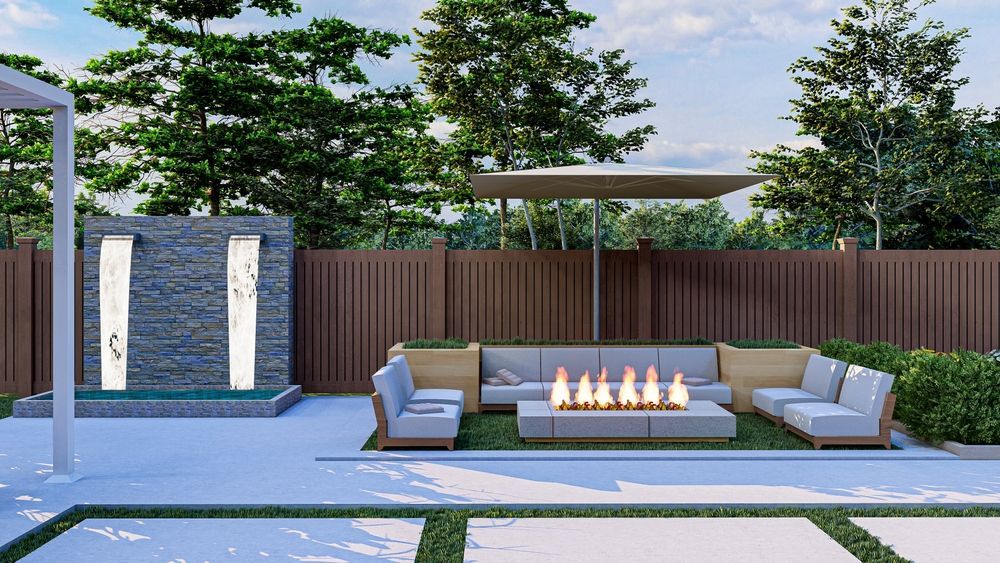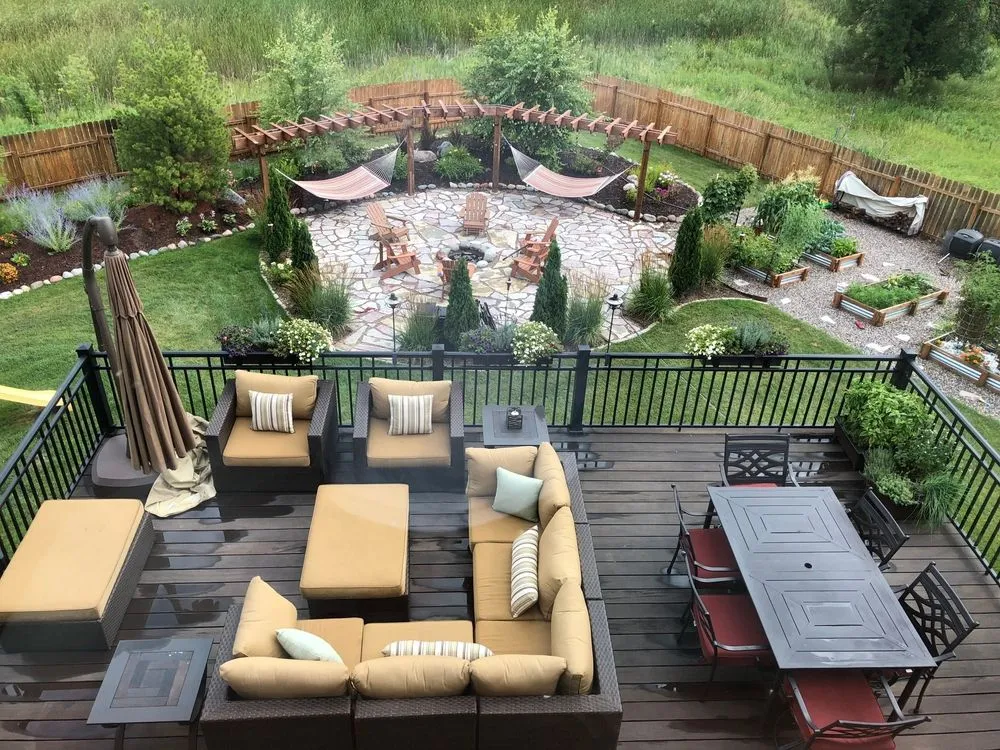Are you concerned about what landscaping is the most fireproof and the increasing frequency and severity of wildfires and want to protect your home from potential fire damage? Creating a fire-resistant landscape around your home can significantly reduce the risk of wildfire spreading to your property.
With the right plants, materials, and layout, you can create a safe and beautiful environment that enhances your property’s aesthetics and protects it from wildfire. In this blog post, we’ll explore the most fireproof landscaping options and provide tips on creating a defensible space around your home, giving you peace of mind and ensuring the safety of your property.
Understanding Defensible Space and its Importance
Defensible Space
Defensible space is an area around your home where vegetation, landscaping, and other flammable materials have been removed, reduced, or modified to slow the spread of wildfire and allow for easier access for firefighters. The size of defensible space may vary based on the area’s surrounding vegetation, topography, and fire history.
The Importance of Creating Defensible Space Around the Home
Creating defensible space around your home is critical to reducing the risk of property damage and loss of life during a wildfire. The goal of defensible space is to create a barrier between the wildfire and your home, giving firefighters a better chance of saving your property.A well-designed defensible space also provides a safer environment for firefighters, reducing the risk of injury or death.
Role of Landscaping in Creating a Defensible Space
Landscaping is crucial to creating a defensible space around your home. Proper landscaping techniques can help reduce the risk of wildfire spreading to your property. You can create a fire-resistant environment around your home by removing dead trees and plants, pruning branches, and maintaining a well-maintained landscape.
Selecting fire-resistant plants appropriate for your climate zone can significantly reduce wildfire risk. Using non-combustible materials for landscaping, such as rocks, gravel, or mulch made from shredded rubber, can also help minimize the spread of wildfire.
Lastly, creating space between plants and structures can slow fire spread and provide easier access for firefighters.

Key Considerations for Fire-Resistant Landscaping
Climate Zone and Vegetation
One of the key considerations for fire-resistant landscaping is understanding your area’s climate zone and vegetation. Different regions have different vegetation types, which can be more or less susceptible to wildfires. By selecting well-suited plants for your climate zone, you can create a fire-resistant landscape that is less likely to ignite and spread.
Choosing the Right Plants
Selecting the right plants for your landscape is another critical consideration for fire-resistant landscaping. Choosing fire-resistant plants that are slow-growing, have low sap or resin content, and are not oily or resinous can help reduce the spread of wildfire. Some fire-resistant plants include succulents, deciduous trees, and plants with high moisture content, such as ferns and mosses.
Materials to Use and Avoid
Choosing the right materials is also essential for fire-resistant landscaping. Using non-combustible materials such as rocks, concrete, and brick can help slow the spread of wildfire.
Avoid combustible mulches like pine needles, shredded wood, or leaves. Instead, consider using mulch made from shredded rubber, composted wood chips, or Western Red Cedar.
key considerations for fire-resistant landscaping include:
● Understanding your area’s climate zone and vegetation.
● Selecting the right plants.
● Choosing non-combustible materials for your landscape.
By following these guidelines, you can create a fire-resistant landscape that helps reduce the risk of wildfire damage to your property.
Best Landscaping Practices for Fire-Resistance
Remove Dead Trees and Plants
Dead trees and plants can act as fuel for wildfires, so it’s crucial to remove them from your property. This includes dead trees and dead or dying branches on live trees.
Prune Branches and Keep Plants Well-Maintained
Regularly pruning branches and maintaining your plants can help reduce the risk of wildfires. This includes removing dead or dying branches, maintaining a healthy plant structure, and keeping your plants hydrated.
Create Space Between Plants and Structures
Creating space between plants and structures is another essential practice for fire-resistant landscaping. This helps prevent wildfires from spreading to your home by creating a buffer zone of non-flammable materials.
Use Resistant Plants and Apply Resistant Mulch
Using fire-resistant plants and applying fire-resistant mulch can also help protect your property. Fire-resistant plants have low sap or resin content, are not oily or resinous, and are slow-growing. Resistant mulch options include shredded rubber, composted wood chips, and Western Red Cedar.
Use Non-Combustible Materials for Landscaping
Using non-combustible materials for landscaping, such as rocks, concrete, and brick, can help prevent the spread of wildfire. In addition, avoiding combustible mulches like pine needles, shredded wood, or leaves is crucial.
Shrubs for fire-resistant landscaping
● Shrubs add fuel to fires and can help them spread quickly.
● Shrubs are considered ladder fuels because they can carry fires into tree crowns.
● Plant only widely separated, low-growing, nonresinous shrubs close to structures.
● Planting plants immediately beneath windows, vents, or wooden decks is not recommended.
● Planting shrubs beneath tree tops is not recommended, nor is screening propane tanks, firewood heaps, or other combustible objects.
● Plant shrubs separately, as specimens, or in tiny groups, and keep them away from any trees inside the defensible space.
● Mow grasses low around bushes and remove dead stems once a year.
● Remove lower branches and suckers from species like Gambel oak to elevate the canopy and keep surface fires at bay.
Fire-Resistant Landscaping Idea
Bay Area Landscaping Ideas
● Mediterranean climate plants, such as lavender, rosemary, and sage, are ideal for the Bay Area due to their low flammability and drought tolerance.
● Succulents, such as agaves and cacti, are also great options as they store water and have minimal foliage.
● Redwood trees and other fire-resistant plants like California lilac and manzanita are great for creating a defensible space.
Denver Landscaping Ideas
● Xeriscaping is a great option for Denver’s arid climate. It involves using native plants that require little water.
● Incorporating hardscaping elements, such as rocks and gravel, can create a fire-resistant buffer zone around the home.
● Native plants like Rocky Mountain juniper and Gambel oak are also great options as they are fire-resistant.
General Landscaping Ideas
● Pine needles can be used as a fire-resistant mulch.
● Composted wood chips can help retain moisture in the soil and reduce weed growth.
● Shredded rubber can be used as a mulching material as it does not ignite easily.
● Western red cedar is a great building material as it is naturally resistant to fire and decay.
Incorporating these landscaping ideas allows you to create a fire-resistant landscape around your home. It’s essential to consider your area’s climate zone and vegetation when selecting plants and materials.
Using fire-resistant plants, mulches, and building materials and incorporating hardscaping elements can create a beautiful and safe landscape that protects your home from wildfire.
FAQs for What Landscaping is the Most Fireproof
Can non-combustible materials be used in landscaping?
Using non-combustible materials like rocks, gravel, and concrete can create a fire-resistant landscape around your home.
What are some fire-resistant plant options for a Mediterranean climate?
Mediterranean climate plants like lavender, rosemary, and sage are low-flammability options for fire-resistant landscaping. Succulents and fire-resistant trees like redwoods are also good choices.
How should I maintain the grassy areas around my home for fire-resistant landscaping?
It is critical to cut the grass low in the defensible space’s inner zones and keep it short closest to the home. Gradually raise the height of the home outward to a maximum of 8 inches. This is especially crucial throughout the autumn, winter, and early spring, when grasses are dry, dormant, and in a “cured” fuel state. Low-growing grasses must also be mowed around the garage, barns, decks, firewood heaps, gas tanks, shrubs, and specimen trees with low-growing branches. The maintenance of grassy areas around your home is critical for fire-resistant landscaping.
Final Thoughts
Choosing fire-resistant landscaping is crucial to protecting your home from wildfires. It involves removing dead plants, using non-combustible materials, and spacing plants to create a defensible space. In areas prone to wildfires, planting fire-resistant plants such as succulents, Mediterranean climate, and native plants can help reduce the fire risk.
Understanding the key considerations for fire-resistant landscaping and applying best practices can go a long way toward protecting your property from the devastating effects of wildfires.


 Pursu Agency
Pursu Agency